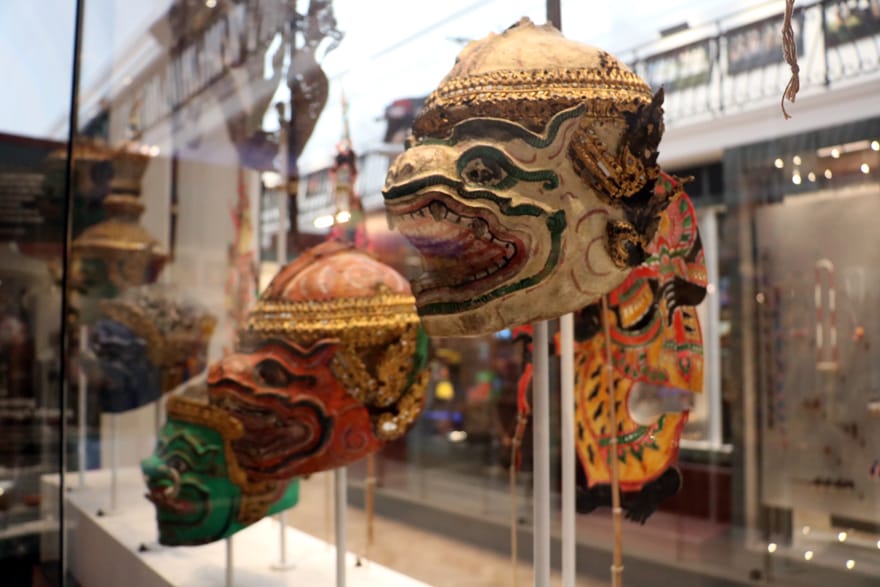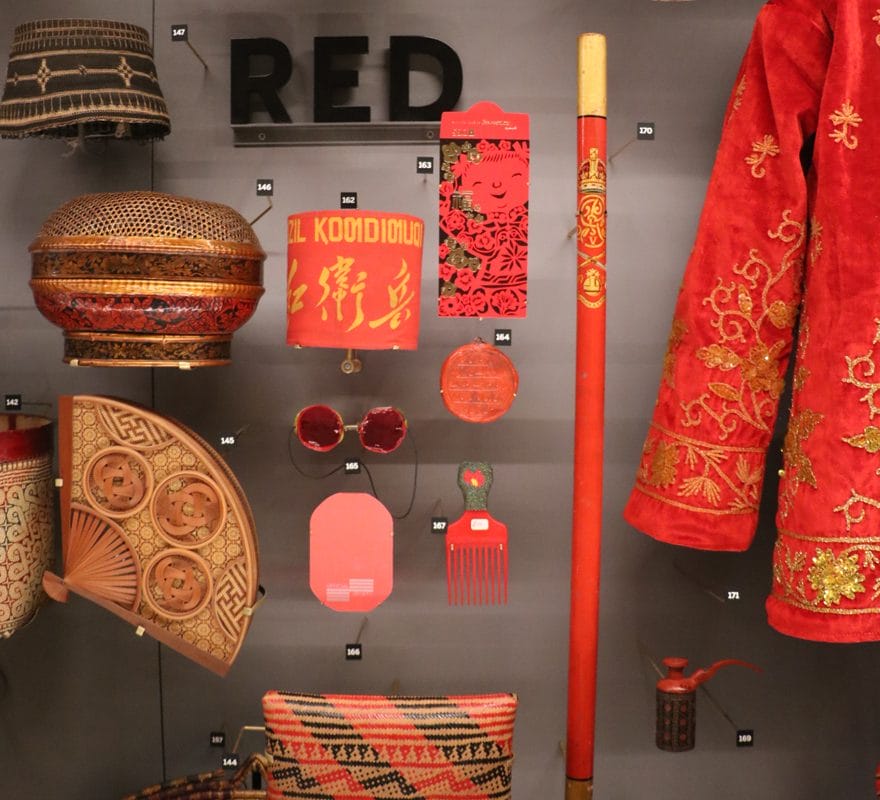- Over 3,000 objects from around the globe will go on show in the new 600 sq m gallery, opening to the public on 29 June 2018
- Visitors will be able to explore our internationally significant anthropology collection through vibrant and insightful displays celebrating the diversity and beauty of the world’s cultures.
- The prow of a Libyan refugee boat, a Tuareg camel saddle, Chinese paper offerings, a Native American tomahawk and a sword made of sharks teeth from Kiribati are among the objects that will go on display, many for the first time in a generation.
The new gallery will provide a beautiful and contemporary setting for our world-class anthropology collection, with over 3,000 objects telling stories from around the world that explore what it means to be human.
Occupying one half of the Horniman’s original building in Forest Hill, South London, the World Gallery is the culmination of more than five years’ work to transform this historic gallery, and recapture the light and spirit of the Horniman when it first opened on 29 June 1901.
Over 100 years later, the World Gallery will be an enriching addition to London, fulfilling Frederick Horniman’s ambition ‘to bring the world to Forest Hill’.
Supported by the Heritage Lottery Fund, the gallery is part of the Horniman Museum and Gardens’ wider mission to encourage appreciation of the world, its peoples and their cultures, and its environments.
Showcasing selected new acquisitions alongside magnificent objects from our existing collection, the gallery will show some of the ways that ordinary people live their lives and make their way in the world we all share. The gallery also includes stories about contemporary issues such as climate change, migration and displacement.



The gallery was developed by the Horniman’s anthropology curators in collaboration with over 200 people from our community networks including local groups, arts organisations, community leaders, international museums, academic partners and representatives of some of those who made and used the objects in the collections.
The World Gallery will be divided into four interlinked spaces:
- an Introductory area – welcoming visitors into the gallery and exploring the sentiments and memories we can associate with objects;
- Encounters – rich displays showing examples of ways of living from every continent and different times and places;
- Horniman’s Vision – an overview of the Horniman’s history; and
- Perspectives – an area that reflects on how and why we categorise, describe and understand the world.
The gallery space is completed with a beautiful display of kites and banners hanging from the newly renovated ceiling vault. Collected and commissioned from Guatemala, China, London and beyond, these emblems signify our human instinct to come together in celebration, play or protest. Highlights include kites by Ahmadzia Bakhtyari, a London-based kite-maker from Kunduz, northern Afghanistan, and a banner created by South East London artist Ed Hall with Horniman volunteers, inspired by the long tradition of Trade Union banners.
Introductory area
The entrance to the gallery introduces the ways in which objects connect people, and the powerful emotions they can evoke. A series of videos feature people from the Horniman’s community groups, volunteers, spiritual leaders, collectors and anthropologists talking about objects of personal meaning to them. These films, presented alongside a display of objects selected for their emotional resonance, will encourage visitors to reflect on objects that hold meaning in their own lives.
Encounters
Encounters will present examples of ways of living from Africa, the Americas, Asia, Oceania and Europe, representing some of the Horniman’s strongest collections. They will explore what it means to live a human life in different times and places.
The African encounters display objects relating to people living in bustling cities, vast deserts and dense rainforests. They explore aspects of life in Nigeria and South Africa, as well as the Mbendjele people of the Congo basin and the Tuareg people of North Africa.
The American encounters look at indigenous peoples of the North American Plains, the Arctic, the First Nations of the Pacific Northwest Coast and Wai Wai people of Guyana and Brazil. They highlight a shared indigenous American understanding of generosity and respect as the basis for all social relations.
The Asian encounters focus on the cultures of China, the Himalayas, Nagaland and Thailand, revealing the diversity of religious belief and cultural practice in the world’s largest continent.
The Oceania encounters explore ways of thinking and living in Australia, Papua New Guinea, Fiji and other islands of the Pacific Ocean. They reflect on the shared respect people have with land and sea, and how objects can create and reaffirm family and ancestral ties.
The European encounters reveal a strong connection between contemporary life and the distant past. Travel, trade and its consequences are explored with a focus on England, Poland, Sweden, Italy and the Mediterranean. The encounters demonstrate a curiosity about other cultures that has been part of a European worldview for thousands of years.
Various artworks will be on display within Encounters, ranging from a work by Lynette Nampijinpa Granites, an indigenous Warlpiri artist whose painting is central to the Australian encounter, to Chinese ancestral hangings and a tattooed self-portrait sculpture by a Naga artist working in London.
A number of contemporary artists have been commissioned to display works in the World Gallery. These include a dress by Nigerian fashion designer Alafuro Sikoki-Coleman, inspired by a female god, Woyingi, once exclusively worshipped by the Ijaw people of southern Nigeria, and a Kiribati Eco-Warrior helmet by New Zealand artist Chris Charteris, which speaks to the importance of resourcefulness when facing the challenges of climate change.
Children are invited to interact with some of the exhibits for a multisensory learning experience. They can touch intricately tooled Tuareg metalwork, arctic seal and reindeer skin, and a digital coral reef. They can smell aromatic herbs used by Bhutanese ritual healers in the Himalayas, listen to epic First Nations’ stories from the Pacific Northwest Coast, and even play in a Lagos market stall.
Perspectives
Perspectives presents objects in a variety of categories, posing questions about how we classify the world around us. Perspectives also examines what anthropology is and explores fieldwork undertaken by anthropologists who collected or donated material to the Horniman. We have also worked with members of our Access Advisory Group to co-curate a display of objects linked to representations of disability and mental illness.
Horniman’s Vision
Horniman’s Vision provides an overview of the Horniman’s history and ethos through the life of its founder, Frederick Horniman, who set out in the 19th century to ‘bring the world to Forest Hill.’
The displays include ancient pottery, European armour and items of natural history from Surrey House, Frederick’s family home, which he opened to the public on the site of the present Museum. Horniman gave his Museum and its collections to ‘the people in perpetuity’ in 1901 to help them discover the world – a legacy that lives on in the new gallery.
The opening of the World Gallery will be an important milestone in the Horniman’s history that will once again place Anthropology at the centre of the Museum. We hope the displays will give us, together with our visitors, the opportunity to explore the many different ways that people can understand and describe the world we all share. Faced with what often feels like the overwhelming consequences of climate change, we want to help our community to think about the ways in which we are all connected, and to draw inspiration from examples of humanity’s resilience, creativity and compassion.
This significant development project has been made possible by the Heritage Lottery Fund (HLF) and the generosity of Trusts and Foundations, donors and individuals. The project has been realised as the result of a £3.3m Heritage Lottery Fund grant, with an additional £1.3m being raised, including a global crowdfunding campaign, which raised over £25,000.


